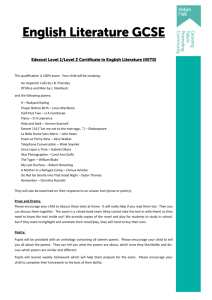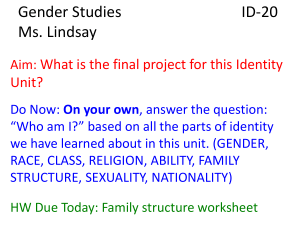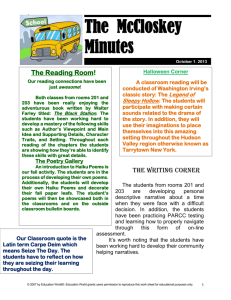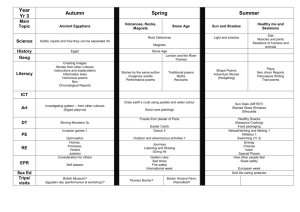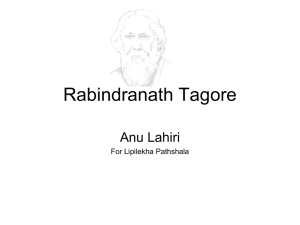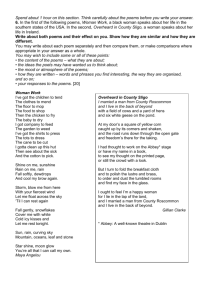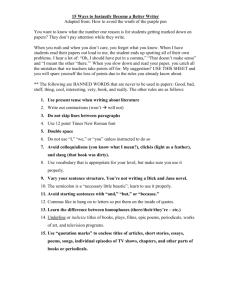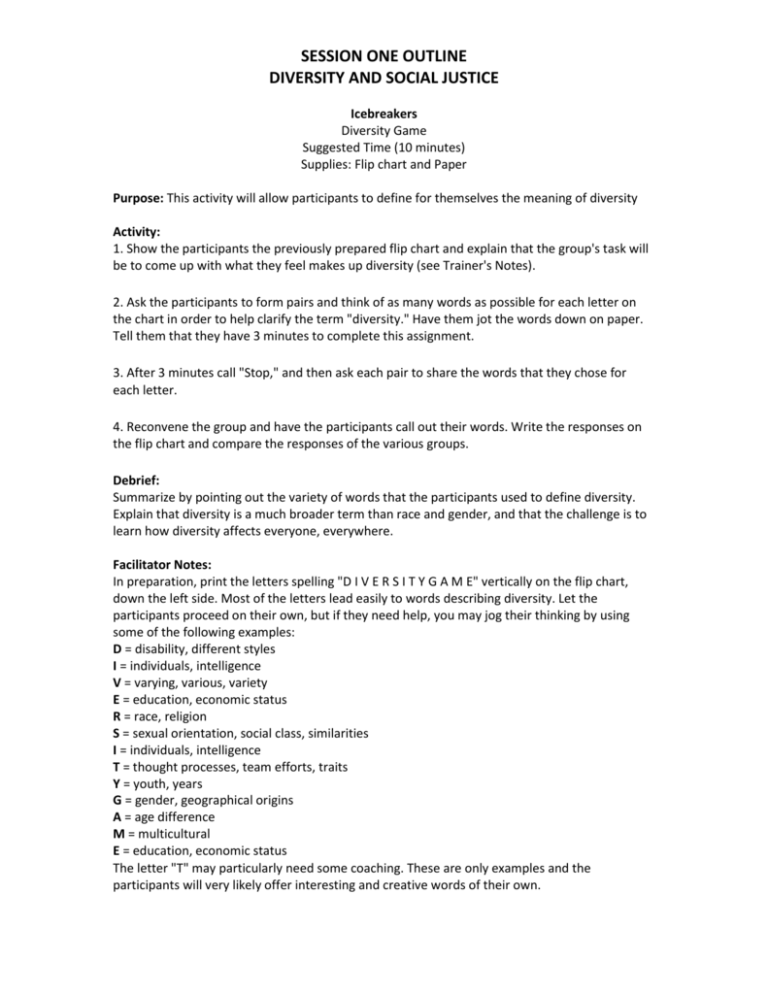
SESSION ONE OUTLINE
DIVERSITY AND SOCIAL JUSTICE
Icebreakers
Diversity Game
Suggested Time (10 minutes)
Supplies: Flip chart and Paper
Purpose: This activity will allow participants to define for themselves the meaning of diversity
Activity:
1. Show the participants the previously prepared flip chart and explain that the group's task will
be to come up with what they feel makes up diversity (see Trainer's Notes).
2. Ask the participants to form pairs and think of as many words as possible for each letter on
the chart in order to help clarify the term "diversity." Have them jot the words down on paper.
Tell them that they have 3 minutes to complete this assignment.
3. After 3 minutes call "Stop," and then ask each pair to share the words that they chose for
each letter.
4. Reconvene the group and have the participants call out their words. Write the responses on
the flip chart and compare the responses of the various groups.
Debrief:
Summarize by pointing out the variety of words that the participants used to define diversity.
Explain that diversity is a much broader term than race and gender, and that the challenge is to
learn how diversity affects everyone, everywhere.
Facilitator Notes:
In preparation, print the letters spelling "D I V E R S I T Y G A M E" vertically on the flip chart,
down the left side. Most of the letters lead easily to words describing diversity. Let the
participants proceed on their own, but if they need help, you may jog their thinking by using
some of the following examples:
D = disability, different styles
I = individuals, intelligence
V = varying, various, variety
E = education, economic status
R = race, religion
S = sexual orientation, social class, similarities
I = individuals, intelligence
T = thought processes, team efforts, traits
Y = youth, years
G = gender, geographical origins
A = age difference
M = multicultural
E = education, economic status
The letter "T" may particularly need some coaching. These are only examples and the
participants will very likely offer interesting and creative words of their own.
SESSION ONE OUTLINE
DIVERSITY AND SOCIAL JUSTICE
Diverse Team Actions That Make a Difference
Suggested Time (15 minutes)
Supplies: Flip Chart
Purpose: This activity will examine the behaviors that lead to becoming an open-minded and
non-judgmental contributing member of a diverse team
Activity:
Explain that this activity offers team members the opportunity to examine their own
perspectives in relation to diversity issues. Pair up the participants and uncover the previous
created flipchart (see Trainer’s Notes). Tell the participants to examine the "Diverse Team
Actions That Make a Difference" on the flipchart and ask the pairs to discuss how those actions
can affect team performance. Instruct the pairs to come up with additional "actions" and write
them down. Allow 5-10 minutes. Have the pairs call out their suggested "actions" and add them
to the list on the flipchart. Reconvene the full group and discuss the additions to the list and
how they will affect a diverse team.
Debrief:
Summarize by asking questions like:
Are these "actions" easy or difficult?
Are they actually realistic?
How do you rank yourselves on these points?
If personal changes become necessary, is it worth it?
As a member of a team, each person has a special responsibility, and sometimes it takes extra
effort to be a valuable team member where diversity issues are involved. There are no firm
answers, but there is strong evidence that those people who are working toward being openminded and non-judgmental are considered extremely valuable to a diverse team.
Facilitator Notes:
Ahead of time, prepare the flipchart as shown below:
Diverse Team Actions That Make a Difference
Looking beyond first impressions to judge a fellow team member.
Trying to pronounce a difficult name of a team member who prefers to be called by his or her
correct name.
Understanding that diverse employees have different perspectives that can contribute greatly to
the team.
Being willing to openly discuss diversity issues.
SESSION ONE OUTLINE
DIVERSITY AND SOCIAL JUSTICE
Who I Am Poems
Suggested Time (15-20 minutes)
Supplies: Paper and pens
Purpose:
In any attempt to increase awareness and encourage self-development, it is crucial to engage
participants in activities that call for introspection and self-reflection. It is also important to
provide opportunities for participants to make connections across, and even within, cultural
lines. The "Who I Am" activity can provide a non-threatening starting point for encouraging selfreflective thought and introspection. It is a safe way for students to think about and share the
influences that have shaped their identities. Also, it continues the connection-making process as
participants find unexpected similarities and differences between themselves and others in the
group.
Preparing and Assigning:
Participants write short poems, starting each line with "I am," encouraging them to describe in
their own words who they are and what's salient to their identity.
Instructions:
Ask participants to take ten to fifteen minutes to write a poem called "Who I Am." Instruct them
that the only rule for the piece is that each line must start with the phrase "I am..." Leave it open
to their interpretation as much as possible, but suggest that they can, if they wish, include
statements about where they're from regionally, ethnically, religiously, etc., memories from
different points in their lives, interests and hobbies, mottos or credos, favorite phrases, family
traditions and customs, and whatever else defines who they are. Be sure to let them know that
they will be sharing their poems.
Facilitator Notes:
In order to ensure that everybody has an opportunity to share her or his story, you might
consider breaking the group into diverse small groups of 8-10 if necessary. Give participants the
option to either read their poems or to share parts of their poems from memory.
Debrief:
Because some individuals will include very personal information, some may be hesitant to read
their poems, even in small groups. It is sometimes effective in such situations for facilitators to
share their poems first. Consider sharing your poem before asking students to write their own
pieces. If you make yourself vulnerable, others will be more comfortable doing the same.
Be sure to allow time for everyone to be able to speak, whether reading their poems or sharing
them from memory. If you're using this as a final activity, not much processing is necessary.
Encourage applause, and thank folks for sharing their poetry. If you use this activity in the
middle of workshop, have some process questions ready. When everyone has shared, ask
participants how it felt to share their poems. Ask what, if any, connections people made with
each other from this activity. What were some commonalities across poems? Did any of these
surprise you? You might also consider asking people to get up and talk to someone who you felt
a connection with through the poetry.
SESSION ONE OUTLINE
DIVERSITY AND SOCIAL JUSTICE
Sample – Who I am Poem
I am basketball on a snowy driveway.
I am fish sticks, crinkle-cut frozen french fries and frozen mixed vegetables.
I am primarily white, upper-middle class neighborhoods and racially diverse schools.
I am Donkey Kong, Ms. Pac Man, Atari 2600 and sports video games.
I am football on Thanksgiving and New Year's Day.
I am "unity in diversity" and "speaking from your own experience."
I am triple-Wahoos, earning three degrees from the University of Virginia.
I am diversity, multicultural education, identity, introspection, self-reflection, and social action.
I am Daffy Duck, Mr. Magoo, Hong Kong Phooey, Foghorn Leghorn, and other cartoons.
I am Tae Kwon Do, basketball, the batting cages, a soccer family, and the gym.
I am a wonderful family, close and loving and incredibly supportive.
I am films based on true stories and documentaries.
I am the History Channel, CNN, ESPN, BRAVO, and Home Team Sports.
I am a passion for educating and facilitating, personal development and making connections.
SESSION ONE OUTLINE
DIVERSITY AND SOCIAL JUSTICE
Lesson
Suggested Time: 45 minutes
Purpose: The privilege walk will help many solidify their core beliefs. This activity can also be
used as a great team building exercise. It does work best, however, if students are familiar with
one another. Privilege Walk can be very intense and emotional for many students, but it allows
them to be able to relate the activity to their own lives by forming their own idea of privilege in
the text and in their own organization.
Objectives:
Students should be able to apply the idea of privilege to their own lives
Students should empathize with those who do not have the privileges they have
Students should be able to apply the idea of stereotypes to their own lives
Privilege Walk (15-20 min): Have students form a line across the room. Ask them the following
questions and instruct them to step back/forward accordingly.
a.
If your primary ethnic identity is American, take one step forward.
b.
If you were ever called names because of your race, class, gender, or sexual orientation,
take one step back.
c.
If you were ever ashamed of your clothes, house, car, etc. take one step back.
d.
If your parents were professionals (i.e. doctors, lawyers, etc.), take one step forward.
e.
If you ever tried to change your appearance, mannerisms, or behavior to avoid being
judged or ridiculed, take one step back.
f.
If you studied the culture of your ancestors in elementary school, take one step forward.
g.
If there were more than 50 books in your house when you grew up, take one step
forward.
h.
If you ever had to skip a meal or were hungry because there was not enough money to
buy food when you were growing up, take one step forward.
i.
If one of your parents was unemployed or laid off, not by choice, take one step forward.
j.
If you were ever denied access to academics or jobs because of your race, class, gender,
ethnicity, or sexual orientation take one step back.
k.
If you were raised in a single parent household, take one step back.
l.
If you were ever accused of cheating or lying because of your race, class, gender,
ethnicity, or sexual orientation, take one step back.
m.
If you had to rely primarily on public transportation when you were growing up, take
one step back.
n.
If you were ever stopped and questioned by the police because of your race, class,
gender, ethnicity, or sexual orientation, take one step back.
o.
If you were ever afraid of violence because of your race, class, gender, ethnicity, or
sexual orientation, take one step back.
p.
If you were ever uncomfortable about a joke related to your race, class, gender,
ethnicity, or sexual orientation, take one step back.
q.
If you were ever the victim of violence related to your race, class, gender, ethnicity, or
sexual orientation, take one step back.
r.
If your parents told you could be anything you wanted to be when you grew up, take
one step forward.
SESSION ONE OUTLINE
DIVERSITY AND SOCIAL JUSTICE
Instruct the students to take a look around and take a seat where you are standing.
Debrief (20 min)
Ask students, questions such as:
What was the purpose of this activity?
How did this make you feel?
Those of you in front, how did you feel? What about those of you in back?
How can you relate this activity to the idea of stereotypes?
Were there questions you were hoping would not be asked? Any you wish had been
asked?
How might such issues/factors affect members of your organization?
How might they affect your relationship with your members?
Did you learn things about yourself or were you forced to think about things you’ve
never thought about before?
What role does privilege play in this?
What role does pride and shame play?

